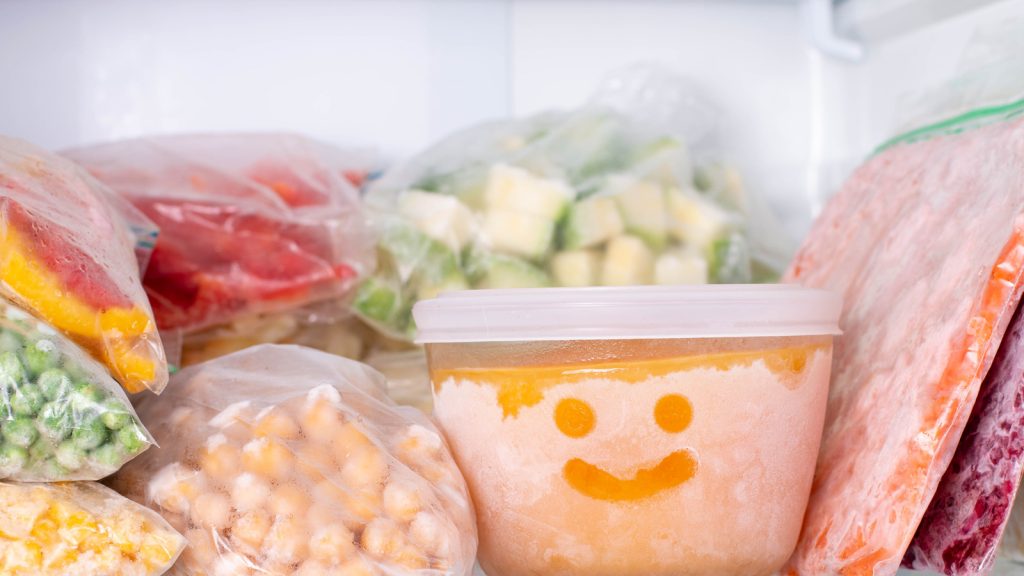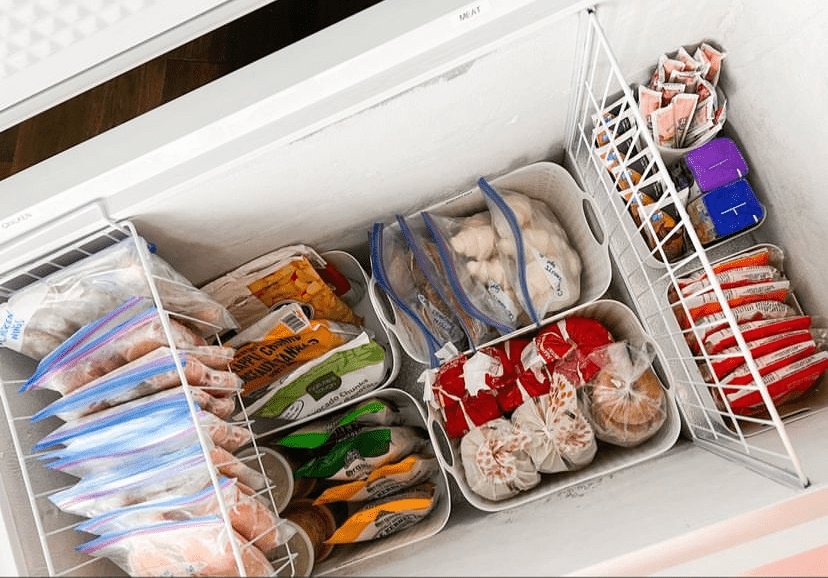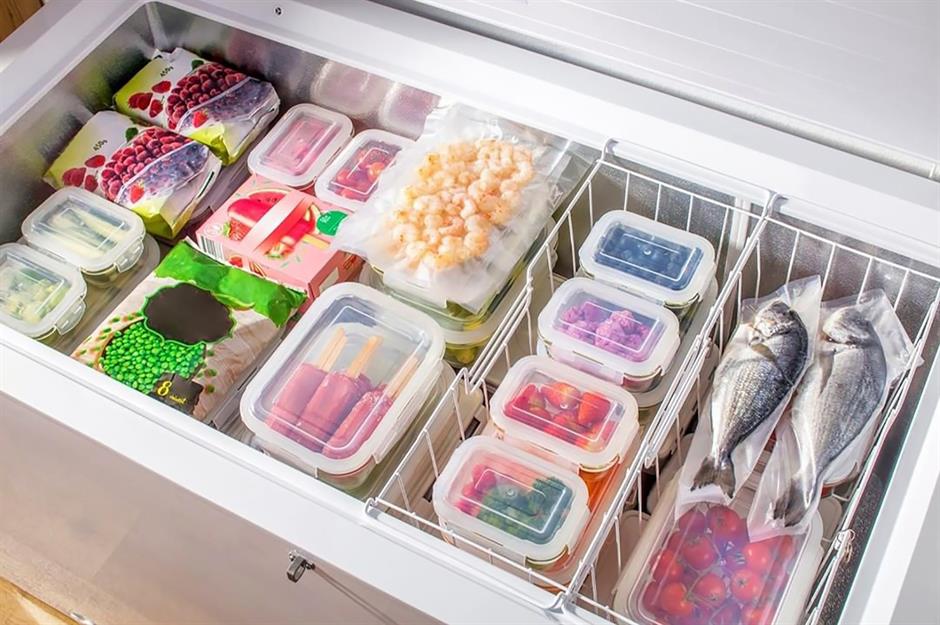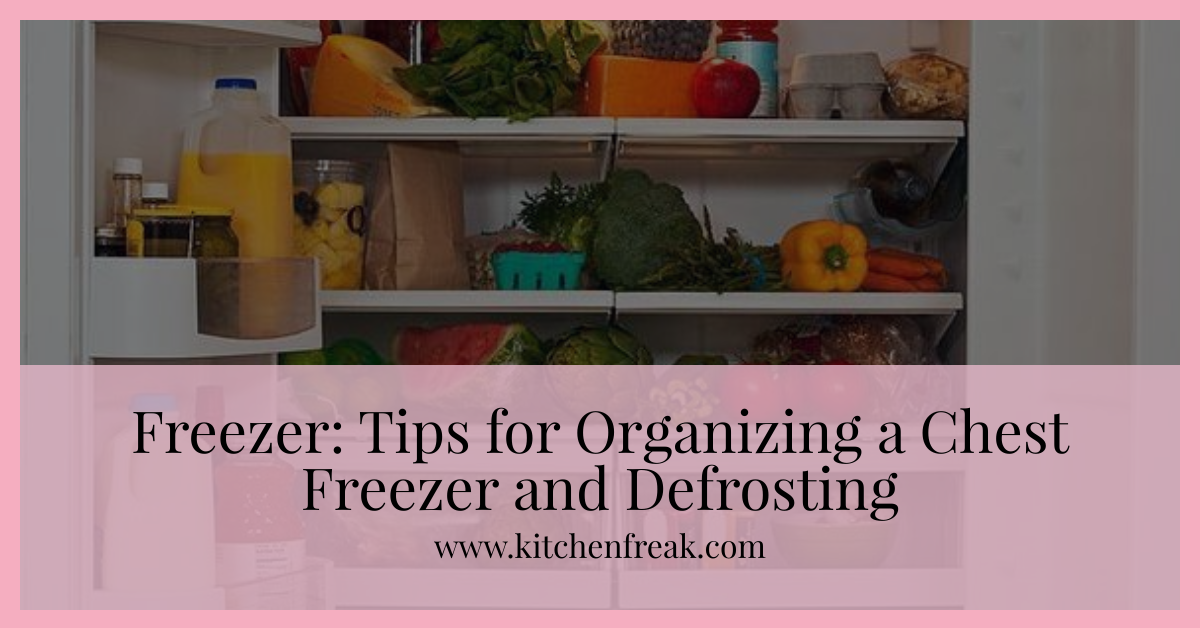Nowadays, refrigerators are often used as fridge-freezer combinations. Older or smaller devices often have at least one ice compartment. If you want to store larger quantities of frozen goods (and have the necessary space in the kitchen, extra room, basement or garage), you should use a pure freezer storage. And now we are faced with the problem of whether a freezer or a chest freezer is the better choice. The most important question after purchase is: How can I defrost the freezer?
Table of Contents
Freezer or chest freezer?
Basically, purchasing a freezer makes sense for anyone who wants to stock up on larger quantities of frozen food. This is especially true for families with children, who naturally generally need more storage space for food. The ice compartment in your refrigerator is usually tiny and fills up in no time. If you still have a sweet tooth and like to eat ice cream, there’s really no way around a freezer if you want to stock up a little.
Frozen foods have a long shelf life and can be prepared quickly and usually very easily. For example, you can bridge Sundays or holidays before which you forgot to shop with delicious meals. To ensure that your food lasts for a long time, your device should not be warmer than -18°C. But stop! deep freeze and freezer are often equated in everyday language. However, there are definitely some differences here.

Where should the freezer be located?
An important question is the future location of the device. A freezer is not very high, but still very wide. There are chests from 82 centimeters long, but also some with 100 centimeters. A freezer, on the other hand, usually has a footprint of 70 x 70 centimeters, but can be of different heights. It can be integrated very well into a kitchen; there is often space for a chest in the basement . You can use the dimensions to decide for yourself what space you have to set up a freezer. If the storage space is limited from the start, you should plan a freezer.
- Cooler room: If you place the device in cooler rooms such as a basement or pantry, you can also save on energy costs, as less cooling needs to be done when the outside temperature is lower.
- Dry room: The room should not be too humid, as high humidity increases the formation of ice in the freezer.
- Distance from the wall: You should also make sure there is enough distance from the wall to ensure good air circulation. Otherwise, the device may become too warm or even mold may form on the walls.
- Air circulation: In fitted kitchens you should therefore make sure that there are enough ventilation slots in the furniture so that heat and moisture can escape.
However, you shouldn’t put your freezer completely outside. You always hear that some people have their freezer outside on the balcony or in the garage. But this can be a problem, especially in midsummer and winter. The higher humidity outside can also affect the device and, for example, B. lead to rust.
However, there are also special freezers that are suitable for outdoor use, such as: B. the freezers that are in front of gas stations. Sometimes you can find something like this cheaply used in classified ads.
Power supply: Choose a location where a power outlet is within reach. Extension cables or power distributors such as multiple sockets can potentially pose a fire hazard. If you need an extension, it is best to ask a specialist retailer or an electrician how this can be solved safely.
How much food is frozen?
When you eat out, do you tend to have small amounts of leftovers that are frozen or do you like to keep food on hand? There is also the question of whether you need the device for yourself or for a whole family. For singles, the freezer elements in a refrigerator are often sufficient. If the two compartments are not enough, you can also buy a small cupboard. If you have a lot of chilled food or even large chilled food, considering a chest makes a lot of sense.

Which device is more energy efficient?
Considering its size and contents, the deep freeze is more energy efficient compared to a freezer. The cold, heavy air sinks down so it doesn’t escape when you open the lid of the chest. The walls of a chest are also thicker than freezers, so a chest is very well insulated overall, so that it runs energy-saving and efficiently. If a chest is only half full, it uses more electricity than a well-filled cupboard.
Advantages of the freezer
- Space required: The freezer requires little space because it has a small footprint and can be integrated very well into a kitchen.
- Keep an overview: The drawers make it easy to keep track of the stored food.
- Access to contents: You don’t have to crawl into the cupboard to get food out.
- Model selection: There is a suitable freezer for every family size.
- More content: The chest offers a larger volume for storing food.
- Energy-saving: Thanks to the tight seal, the chest works very energy-efficiently.
- For families: For large families where a lot of food is stored, the chest is the device of first choice.
Pay attention to storage space and energy label
To ensure that you end up with a device that meets your expectations, you should pay attention to a few important points. On the one hand, you have to consider how much storage space the device should have. There are various model variants from 80 liters to 235 liters, although a maximum size of 195 liters should be sufficient for a private household. Remember that even larger devices consume significantly more power. Which brings us to the next point: the energy label. Here you should make sure that the freezer costs as little energy as possible. Other factors that could significantly influence your purchase decision are the functionality and volume of the device.
Store the freezer properly
Which foods go in which compartment? What is the best way to organize your freezer or chest freezer? Compared to a refrigerator, the temperature differences in an egg cabinet are not quite as great. It is only slightly cooler below than above. That’s why it almost doesn’t matter what is conceded and where. But you should pay attention to some order, as a freezer should be open for as short a time as possible. So if there is chaos in your device and you have to spend a long time looking for certain frozen goods, it costs a lot of energy. It’s best to put something that you’ll only store for a short time or want to take out often at the top. Things that in the longer term e.g. B. that should remain frozen until winter come down.

Organizing a chest freezer
Organizing a deep freezer efficiently can help maximize space, keep items easily accessible, and prevent food waste. Here’s a step-by-step guide for deep freezer categorization:
1. Clean and Defrost:
- Before organizing, ensure your chest freezer is clean and free from frost buildup. If needed, defrost it according to the manufacturer’s instructions.
2. Categorize Items:
- Group similar items together. Common categories include stack of meats, vegetables or frozen veggies, fruits, prepared meals, milk crates and frozen treats.
3. Invest in Storage Containers:
- Use storage containers, crate or bins to keep similar items together. Clear bins make it easy to see what’s inside.
4. Label Containers:
- Label containers with the contents and date of freezing. This helps you easily identify items and prioritize older ones.
5. Consider Zones:
- Designate specific areas for different categories. For example, reserve the top for ice cream and frozen treats, the middle for meats, and the bottom for vegetables.
6. Use Stackable Bins or Baskets:
- Stackable bins or baskets make it simple to access items at the bottom without having to unload the entire freezer. Opt for ones with handles for easy lifting.
7. Invest in Vacuum-Sealed Bags:
- Vacuum-sealed bags are excellent for saving space and preventing freezer burn. Use them for meats, vegetables, and other items you plan to store for an extended period.
8. Lay Flat Whenever Possible:
- Whenever possible, lay items flat to maximize space and make it easier to access different layers of the freezer.
9. Use Shelving Units:
- If your deep freezer is deep, consider adding small shelving units to create different layers. This makes it easier to organize and access items.
Organizing your chest freezer requires a systematic approach to ensure efficiency and prevent food waste. Regularly review and adjust the organization as needed, and be mindful of maintaining proper temperature levels for optimal food preservation.

Food storage in chest freezer
Proper food storage in a chest freezer is essential to maintain freshness, prevent freezer burn, and optimize space. Follow these guidelines to organize and store food effectively in your chest freezer:
1. Categorize and Group:
- Group similar items together for easier retrieval. Common categories include meats, vegetables, fruits, prepared meals, and frozen treats.
2. Invest in Quality Storage Containers:
- Use airtight, moisture-resistant containers to prevent freezer burn and protect food from odors. Clear containers help you easily identify the contents.
3. Package Items in Small Portions:
- Divide bulk items into smaller portions before freezing. This allows you to thaw only what you need, reducing food waste.
4. Create Zones:
- Designate specific zones for different food categories. For example, reserve one section for meats, another for vegetables, and another for prepared meals.
5. Stackable Bins or Baskets:
- Utilize stackable bins or baskets to create layers in your deep freezer. This makes it easier to access items at the bottom without having to unload the entire freezer.
6. Temperature Monitoring:
- Regularly check and monitor the temperature of your chest freezer to ensure it stays within the recommended range for chilled food storage (typically 0°F or lower).
By following these tips, you can maintain an organized and efficient chest freezer that keeps your chilled foods in optimal condition.

Defrost and clean the freezer
When you open and close the freezer, a layer of ice forms on the walls of the device. The thicker this layer of ice becomes, the more electricity the device uses, which of course has an impact on your wallet. Even if it is an unpleasant job that is often put off, this ice should be removed.
So before you buy new supplies, you could defrost the freezer. This is also a good way to re-sort all your food. You must store the remaining food in a cool place while cleaning . A cooler bag with ice packs is best . The fridge is too warm for that. A winter day with temperatures below zero is also a good option, so you can temporarily store the frozen goods on the balcony, for example.
There are now also refrigerators with a self-defrosting function. Thanks to this automatic defrosting, larger pieces of ice hardly ever form. You not only save work but also electricity.
There are also refrigerators with no-frost technology. By using this technology, the humidity in the freezer compartment is reduced, so that the food and walls of the freezer become less frosty. There is no need to defrost because the refrigerator does not ice up.
Defrost the freezer
Clear out the device and store the food in a cool place. Then do the following:
- Unplug: To defrost and clean, unplug the freezer.
- Open the door: Then open the door wide.
- Avoid flooding: Before defrosting, you should place enough towels in front of the freezer to absorb the water that is created when it melts and flows out of the device. It’s best to use towels that need to be washed anyway. Then you save yourself additional work.
- Overnight: If you’re not in a hurry, you can leave the cupboard open overnight and clean it the next morning.
- Faster with salt: If things have to happen quickly, you can speed up defrosting. Sprinkle the ice surfaces with salt to lower the melting point.
- Hot Water: Or place a bowl of boiling hot water in the freezer. Once it has cooled down, a new one goes in. The hot steam also accelerates defrosting.
- Avoid: Do not scrape the ice with a metal object as you may damage the device.
Clean freezer
After defrosting, you can clean the device. If you don’t clean the freezer regularly, bacteria will multiply and then odors may develop and your freezer suddenly smells.
- Wipe: Wipe drawers, walls, and door with a mild cleaner.
- Drawers: The individual drawers should also be removed and washed out. If necessary, shower them off in the bathtub.
- Seals: Pay particular attention to the rubber seals as well as grooves and recesses in the cabinet.
- Drain: When cleaning, don’t forget the drain, even if it is very inconspicuous. This opening can be cleaned very easily with cotton swabs .
- Drying: Wipe everything dry well.
Below I will introduce you to a few home remedies for cleaning the freezer:
Vinegar
Wipe the entire cabinet with a mixture of water and vinegar and wipe dry.
Citric acid
Citric acid is even better because it doesn’t attack the seals.
Baking powder or baking soda
Two tablespoons of baking powder or baking soda and one liter of warm water make an excellent cleaning solution that is not only cheaper but also more effective than most cleaners.
Glycerin
Another little tip – if the inner walls are thinly coated with glycerin after cleaning, new ice will not form as quickly.
Put the freezer back in place
After cleaning, you can fill the device again. The better the freezer is filled, the less power it has to provide and the less electricity it uses. Take advantage of the opportunity and use freezer containers with lids in different colors to keep track of your frozen goods in the future. Please note the instructions under “Store the freezer correctly” above.
Malfunctions and repairs
Sometimes unpleasant incidents occur with your freezer. The freezer suddenly beeps, hums loudly, gets hot, leaks water or no longer cools properly? The manual can often help here. If you don’t have it to hand, do some research online. For example, enter the model name and “operating instructions” or “PDF” into Google.
With a little skill, you can often take care of minor errors or repairs yourself. Important: Before you do anything on your device, please be sure to unplug it first to avoid contact with electricity.
If you have tried everything but cannot find the error, contact a service technician. You can get addresses on the Internet or in the yellow pages of your district. Specialist dealers also often offer a repair service.
Where can you dispose of the freezer?
If your freezer is old or defective and repairing it no longer helps, you can simply dispose of it free of charge at your community’s recycling center. However, this only applies to private individuals. Traders have to pay a fee for this.
Sometimes specialist retailers will take your old device if you buy a new one from them.
FAQs
Q: What are some tips for arranging a chest freezer?
A: Some tips for organizing a deep freezer include using freezer baskets, plastic bins, milk crates, and dividers to create more space and make it easier to find what you’re looking for.
Q: How can I make more space in my chest freezer?
A: You can make more space in your deep freezer by stacking and using organizing systems such as crates, bins, and dividers to maximize the available space.
Q: What are some freezer organization ideas for a deep freezer?
A: Some freezer arrangement ideas for a deep freezer include using dollar store order containers, creating a top layer for easy access, and using a freezer inventory printable to keep track of items.
Q: What is the best way to arrange a chest freezer?
A: The best way for chest freezer organization is to measure the space, choose appropriate organizing containers and dividers, and create a system that makes it easier to find and access items at the bottom of the chest.
Q: How do I go about defrosting a chest freezer?
A: To defrost a deep freezer, unplug it and remove all items. Allow the ice to melt naturally or use a fan to speed up the process. Once the ice is melted, clean the interior and dry it thoroughly before plugging it back in.
Q: What should I keep at the bottom of the chest freezer?
A: It’s best to keep items that you don’t need to access frequently at the bottom of the deep freezer, such as large cuts of meat or bulk items that can be stored for a long time.
Q: What is the benefit of using plastic bins to organize a chest freezer?
A: Using plastic bins to organize a deep freezer helps to contain items, prevent them from getting lost at the bottom, and makes it easier to lift and move multiple items at once.
Q: Can I use cardboard boxes to organize my chest freezer?
A: While cardboard boxes can be used, they are not the most practical option for organizing a deep freezer as they may not withstand the cold and moisture as well as plastic bins or crates.
Q: Are there any specific organization systems for a small chest freezer?
A: Yes, for a small deep freezer, it’s important to choose bins and dividers that fit the dimensions of the freezer, and consider using freezer bags and compact organizing solutions to maximize the space.
Q: How can I easily find what I’m looking for in my chest freezer?
A: To easily find what you’re looking for in your deep freeze, consider using clear plastic bins, labeling items, creating sections for different types of food, and regularly reviewing and updating your freezer inventory.

